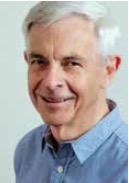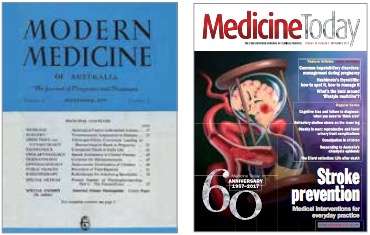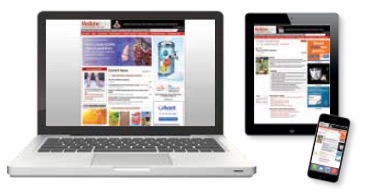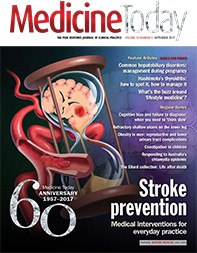Reflections: 60 Years of Medicine Today
60th Anniversary Special
 From the Chair: past, present and future
From the Chair: past, present and future
Professor Kim Oates
AM, MD, DSc, MHP, FRACP
First, think for a moment of the changes that have occurred in Medicine Today’s life so far.
The birth control pill was developed and Sputnik, the first artificial earth satellite, was launched the same year that our journal (then known as Modern Medicine of Australia) was first published in Australia.
The year we turned 4, Yuri Gagarin became the first man to fly in space. In our sixth year the oral polio vaccine was invented, followed a year later by the measles vaccine in 1963. Our 10th birthday in 1967 saw the first coronary bypass graft surgery. When we were 12, Neil Armstrong took man’s first steps on the moon: ‘One small step for man. One giant leap for mankind’. Just after we turned 15, the MRI and the mobile phone were invented, although it was some time before they were more widely available.
The personal computer appeared when we were 18, and the GPS (Global Positioning System) was invented in our 21st year. We were nearly 40 when the internet and email became widely available in Australia. And now there is not only email, but also Facebook, Twitter and Instagram. When I asked my grandchildren if that was the complete list, there was a tolerant groan and they suggested adding Snapchat, Tumblr, Pinterest and Flickr. Yes, it is hard for some of us to keep totally up to date, another reason why Medicine Today is so valuable.
Medicine Today hasn’t been left behind by any of these advances. It has reported medical discoveries as they happened and, in particular, reported them in a way that has been accessible to GPs. It has embraced the new technologies as they developed. Our website is a great example of this. Do you need a patient handout on a particular topic? They are all there on our website. Do you need a flowchart for a particular problem? Again, they are all there. Readers can explore past issues, review the dermatology quizzes, have access to all the supplements and take advantage of the CPD program. And, unlike some websites, it’s user-friendly.
"Medicine Today ... has reported medical discoveries as they happened and, in particular, reported them in a way that has been accessible to GPs."
Medicine Today is a peer-reviewed, independent journal of education, written specifically for GPs by national experts. It’s also valuable for specialists who can read about areas outside their own field of expertise, remaining informed about advances in the whole spectrum of medicine.

We are proud of our editorial independence. All articles are peer reviewed by at least three specialists in the relevant field, including a GP. All authors are required to disclose any commercial or financial association that could be, or even seen to possibly be, a conflict of interest. We do not accept papers that have any known input from pharmaceutical companies, other commercial groups or public relations firms. This independence and peer-review process have made us credible and trusted.
Sixty years ago, when our name was Modern Medicine of Australia, the journal was owned by The New York Times publishing house, with much of the content coming from doctors in the USA. As we developed, our Australian content increased particularly through the 1990s, and in 2000, our 43rd year, we became independent, fully Australian owned, with content written by leading Australian experts. It was time to change our name to Medicine Today.
Over the years, we have listened to our readers, opinion leaders and consultants and made changes appropriately, resulting in feature articles, flowcharts, patient handouts to use in the surgery and regular short articles covering 20 different aspects of medicine, including our Dermatology Clinic, Emergency Medicine, Practical Procedures, Gastroenterology Clinic, Travel Medicine Update and Infectious Diseases Clinic. And of course the popular In Brief and Journal Watch sections present news items about recent research, with commentary on its significance by a relevant expert.
The journal has expanded into an impressive family of publications, including Cardiology Today, Endocrinology Today, Pain Management Today and Respiratory Medicine Today, all overseen by senior clinicians as editors-in-chief and editorial boards of specialists appropriate to the topic. As with Medicine Today, they all have the same editorial independence and avoidance of conflict of interest.
What will the next 60 years bring? Looking at the speed of change in recent years, we can be quite confident that future advances in health care will be even more rapid and more astounding than in the past 60 years. Based on so many unanticipated discoveries in our first 60 years, the only accurate prediction is that the advances are likely to be so great that they are unpredictable.
But I think it’s safe to predict that Medicine Today, in some form, will still be here, continuing to develop like a fine red wine and providing practical, clinically focused, evidence-based information that will help GPs and others provide better care for their patients.
 Reminiscences of 60 years of reading and learning
Reminiscences of 60 years of reading and learning
Professor Peter A. Castaldi
AO, MD(Syd), DU Paris(Hon), FRACP
The 60th anniversary of Medicine Today is a good time to reflect on how the reading and learning habits of medical practitioners persist and adapt over the years. As young medical graduates in the 1950s and 1960s, we were placed under the supervision of senior practitioners, the ‘Honoraries’ of those times. They were mostly kind and a little indulgent but, when we were fortunate, we became the juniors to outstanding clinicians and mentors who were well read, firm, critical and often personally strongly supportive. We were compelled to read avidly and perform on rounds and in presentations, striving to make the grade as physicians, surgeons or whatever path we chose. In the 1960s, I discovered Modern Medicine of Australia. By then the journal was established as a useful companion for coverage of medical topics. I always checked its contents on the library shelf, and remember ward rounds being stimulated by the latest issue. We responded to ideas to which we could relate and that sometimes challenged our capacities.
"To preserve our communication we depend on journals that can provide...the type of grounded information so typical of that in Medicine Today."
Where are we now, all these years later, when we find that simply perusing a few trusted sources leaves us short of the awareness we seek? In the digital age, do we still see value in print journals, do we have the access we need and the information on which we depend? It is striking how the same topics recur as information grows and flows. The more we diverge into specialist pathways, the more we need the reassurance of continuing values in clinical excellence. To preserve our communication we depend on journals that can provide a meeting place for specialties and the type of grounded information so typical of that in Medicine Today.
On this 60th anniversary, I would like to pay tribute to Judy Passlow and Tony Scott, the longstanding directors of this journal, and also to the editors, production staff, contributors, reviewers, editorial board, and finally the readers, for their continuing support.
 There and back again
There and back again
Audra Barclay
MB BS, BSc(Med)
Around 15 years ago, I started my medical publishing journey at Medicine Today as an assistant editor and medical writer. I recall attending the job interview with a mock-up newsbite about a dog who could detect when their owner was hypoglycaemic.
(News)Bite, dog – get it? I was trained editorially at Medicine Today by the best; but even they didn’t attempt to work on my sense of humour.
I left Medicine Today to pursue my interests in medical education, data and digital communication and now, 10 years later, I have returned with fresh eyes. Last year when I rejoined the team, what struck me first was the high quality of the journal. I have also had the opportunity to speak regularly with our GP readers at conferences and during phone queries; they almost invariably say Medicine Today is their ‘favourite’ medical journal. I have been contemplating why this is; here are my top three reasons:
- The authors. We find exceptional authors with significant clinical experience or expertise in the topic. Unlike many publications, we don’t accept students or junior medical officers, even as coauthors, out of respect for our qualified GP audience who are specialists in their own right.
- The reviewers. Usually three specialists, including a GP, review our articles, a contribution that is valued by many of our authors who ask us to thank the reviewers for their input.
- The staff. The team has an exceptional level of editorial expertise to make any article easy to read and pertinent information easy to find.
What’s new since I left 10 years ago? The sister journals – Cardiology Today, Endocrinology Today, Pain Management Today and Respiratory Medicine Today, published online and in print – provide more in-depth content on bread and butter GP topics and allow specialists to see what their peers are recommending.
What next? Digital media allow more immediate access to information. So we are trialling providing cutting edge conference information through the eyes of Australian clinicians in one- to two-minute video highlights online and in print. We are starting this month by covering the European Society of Cardiology Congress in Barcelona, the largest cardiology meeting of the year to be attended by more than 35,000 delegates. View our coverage here >>
It’s an exciting time to be part of a leading medical publication that is committed to staying relevant and keeping its readers up to date. Stay tuned...
 Two peas in a pod
Two peas in a pod
Judy Passlow
We’ve been together a long time, Medicine Today and I. In May 1979 we made our acquaintance. We were both 22 years old, born in 1957, me in June and her in September. She was known as Modern Medicine of Australia and was owned by The New York Times, my employer. Popular and well respected even then, an active Editorial Board of esteemed physicians and surgeons headed by the father of neurosurgery, Sir Douglas Miller, Chairman of the Board, and Dr John Ellard, Editor, guarded her virtue and honed her knowledge and wisdom.
In those early years of our relationship I toiled long and hard, first as a production assistant, later as production manager, responsible for laying out the pages of the journal. It was cut and paste back then and not until 1992 did we discover the technical wizardry of desktop publishing. Later still I became the Editorial Director and Publisher.
The New York Times sold Modern Medicine to the Adelaide Advertiser in 1983. Within a year it was sold again to Adis Press, then publishers of Current Therapeutics and Patient Management but the marriage was an uncomfortable one, so in 1985 Modern Medicine moved on again, this time into the welcoming embrace of my business partner, Tony Scott, and me, finding home.
Under our stewardship and the watchful guidance of the Honorary Editorial Board, the gatekeepers of our clinical standards, Modern Medicine graduated from a franchised title publishing a mix of international material to an independent, rigorously peer-reviewed journal of original clinical reviews authored by Australian experts across all fields of medicine.
In 2000 we relaunched the journal as Medicine Today, sadly but necessarily forsaking our hard-earned volume number owing to a legal dispute with the US trademark holders. Most of our readers caught on and the journal continued to thrive in its newer livery.
The staff of this fine publication are a passionate lot, some never having worked elsewhere. We have seen our staff marry and have children, watched them mature into adults. We have welcomed keen medical students as avid subscribers and watched them grow into fine GPs and consultants, content in the knowledge that Medicine Today has contributed to their education along the way.
Sometimes I have thought of Modern Medicine/Medicine Today as my own child, sometimes as my sister. Irrespective she has grown so much wiser than me. We each still have a lot to offer and the time to do it. After all, we are only 60!
A decade of growth at Medicine Today
Entry into the digital age
 Our entry into the digital age was an enormous undertaking, starting in 2007 with the launch of the online version of our RACGP-accredited continuing professional development (CPD) program. This widely used site was then integrated into our fully fledged Medicine Today website, launched in 2010.
Our entry into the digital age was an enormous undertaking, starting in 2007 with the launch of the online version of our RACGP-accredited continuing professional development (CPD) program. This widely used site was then integrated into our fully fledged Medicine Today website, launched in 2010.
At launch our website provided readers with the current issue’s content, several years of archived articles, supplements, patient handouts, clinical flowcharts, collections of regular series and topics, a weekly dermatology quiz and our CPD program.
Today, the full text of all articles published in Medicine Today and its sister journals is fully archived back to the year 2000 or to each journal’s launch date. And since February this year, articles have been accessible in both html and pdf formats.
Subscribers to Medicine Today now have online access to more than 2500 articles, 300 clinical flowcharts, 30 supplements, patient handouts and an extensive library of dermatology quizzes.
Over the years several upgrades have been made to the website to improve and enhance our readers’ experience. Our most recent upgrade has ensured that the website provides a fully interactive mobile-responsive platform that can be easily navigated and read on all electronic devices.
Expansion of the Medicine Today group of journals
Launch of four sister journals
 With the aim of providing GPs with more in-depth content on specific therapeutic areas to support and enrich their daily practice, we launched an expansion program in 2011, seeing the Medicine Today base grow over the next five years from one clinical journal to five, available in both print and online.
With the aim of providing GPs with more in-depth content on specific therapeutic areas to support and enrich their daily practice, we launched an expansion program in 2011, seeing the Medicine Today base grow over the next five years from one clinical journal to five, available in both print and online.
Like Medicine Today, its sister journals are all independent and rigorously peer reviewed, providing clinically focused, practical, evidence-based articles designed to meet the needs of busy doctors, and written by highly experienced senior clinicians.
- Cardiology Today. Launched in April 2011, Cardiology Today is published three to four times yearly with content steered by Editor-in-Chief Professor David Brieger, Head of Coronary Care and Coronary Interventions at Concord Hospital, and Professor of Cardiology at The University of Sydney.
- Endocrinology Today. Medicine Today’s second sister publication, Endocrinology Today, was launched in April 2012 under the helm of Editor-in-Chief Professor Stephen Twigg, Professor of Medicine at The University of Sydney’s Sydney Medical School and Head of the Royal Prince Alfred Hospital’s Department of Endocrinology.
- Pain Management Today. January 2014 saw the launch of Medicine Today’s third sister journal, the biannual Pain Management Today. Its Editor-in-Chief is Professor Roger Goucke, Consultant in the Department of Pain Management at Sir Charles Gairdner Hospital, and Clinical Associate Professor at the University of Western Australia, Perth.
- Respiratory Medicine Today. Medicine Today’s newest clinical journal, Respiratory Medicine Today, was launched in October 2016. Published biannually, it is overseen by Co-Editors-in-Chief Professor Christine McDonald, Director of the Department of Respiratory and Sleep Medicine at Austin Health, and Professor of Respiratory Medicine at The University of Melbourne, and Professor Peter Frith, Professor in Respiratory Medicine at Flinders University School of Medicine, and Adjunct Professor at University of South Australia Health Sciences Faculty, Adelaide.
Other publications
In addition to expanding our base of clinical journals, over the past decade we have continued to provide readers with carefully selected collections of updated peer-reviewed articles on specific areas of medicine. During this time we have published more than 20 supplements on topics as diverse as asthma, diabetes, prescription opioid misuse, contraception, androgen deficiency and stroke, and in May 2016 we launched our biannual Dermatology Collection. This publication provides updated dermatology articles selected by its Editor-in-Chief, Professor Gayle Fischer, Associate Professor of Dermatology at Sydney Medical School – Northern, University of Sydney, Royal North Shore Hospital, Sydney.
The future - what's in the pipeline?
The publishers of Medicine Today believe in print. Digital disruption has been a real force for some years, but the actual impact of digital media is only now becoming clear.
Worldwide, newspapers in print are under siege and seemingly fighting a losing battle, although there remains a hard core of readers who love all that black ink. Niche journals and magazines have fared better and indeed are enjoying somewhat of a renaissance. The publishers of Medicine Today have invested in independent research on doctors’ preferred sources of information, repeated four times since 2006, most recently in November 2015. The data clearly show that GPs have remained avid followers of traditional media. Print clinical journals are not going to disappear any time soon. Annual syndicated readership surveys show that within the month of publication Medicine Today is read by 69% of all GPs. In the following weeks that figure reaches virtually 100%.
So what next for Medicine Today? Our rigorously peer-reviewed content will continue to evolve to meet our readers’ needs. Feature articles attract the highest readership so will always have a place. New clinics will be added in response to feedback from readers and changes in medical practice. Do not hesitate to let us know if there is anything you would like covered. We are listening and you can help shape our future!
We are also looking to bring the world of scientific and medical breakthroughs to your inbox in an easy-to-digest form. As this issue goes to press, Cardiology Today staff are attending the European Society of Cardiology Congress in Barcelona to provide coverage for Australian readers. Ninety-second video highlights are available by email with links to more information should you desire it. We will also provide print coverage in the October issue of Cardiology Today. If this style of reporting proves popular we will do more of it. Perhaps you can’t make it to such international conferences yourself, so why not let us go for you?
What else might lie ahead? The pace of change has been so rapid over the past 10 years that it is impossible to imagine where we might be or what we might look like in another 10. One thing we feel certain of – Medicine Today and its sister journals will still be there, helping the GPs of today and tomorrow keep up to date just as we have done since 1957.
Thank you for joining us on this journey.
Whatever happened to Modern Medicine?
 Good question...how can Medicine Today be 60 years old and only at volume 18? Our more mature readers may remember our earlier incarnation as Modern Medicine of Australia, but the younger generation may never have heard of it.
Good question...how can Medicine Today be 60 years old and only at volume 18? Our more mature readers may remember our earlier incarnation as Modern Medicine of Australia, but the younger generation may never have heard of it.
Modern Medicine was born in the USA in 1933 and licensed around the world. The first Australian edition was published in September 1957 and the last in December 1999. The new millennium saw a new name and a fresh look as Medicine Today, Volume 1, Number 1, January 2000. But the Australian publishers did not give up the original name and volume number lightly.
For years they tried to negotiate with the US owners of the Modern Medicine trade mark. The associated royalty had reached crippling levels, while the US owners no longer offered any support or original content. Indeed, the other international editions of Modern Medicine relied on the Australian edition for content, yet all paid the same royalty to the US. Modern Medicine of Australia was paying a royalty for producing its own Australian content, and also being deprived of income for sharing its content with international editions. The US owners refused to negotiate.
By 1999, change was essential to survival. Under legal advice, Medicine Today was launched as a totally new publication with its own ISSN library number and volume; hence, Volume 1, Number 1. Within three months the US owners realised the consequences. Belatedly they offered the Modern Medicine trademark at a fire sale price, and it was snapped up, securing it in Australia. Thus occurred the demise of Modern Medicine and the genesis of Medicine Today. It was a shame for the proud name Modern Medicine, but the publishers consoled themselves that the journal’s survival was assured and that Medicine Today was a more modern name for the new millennium.
What do you think?


